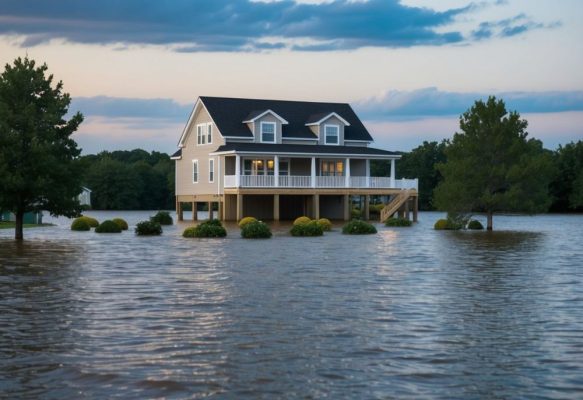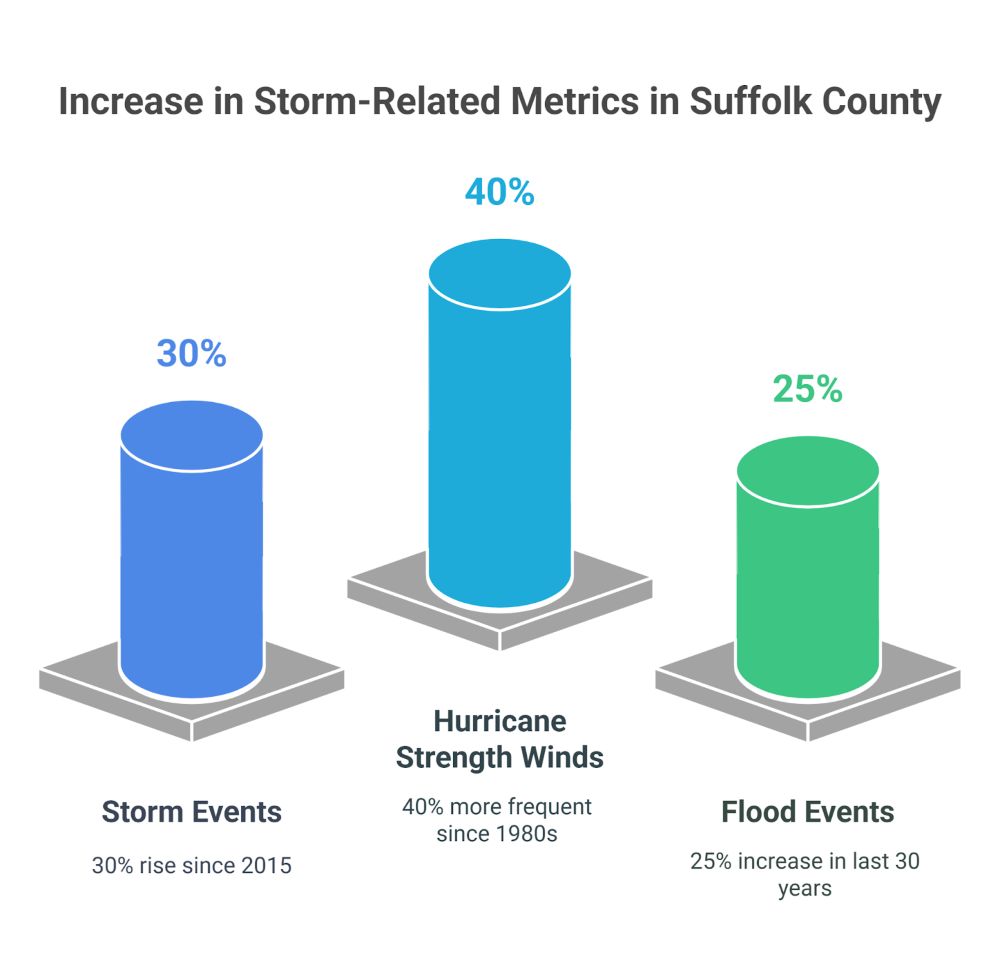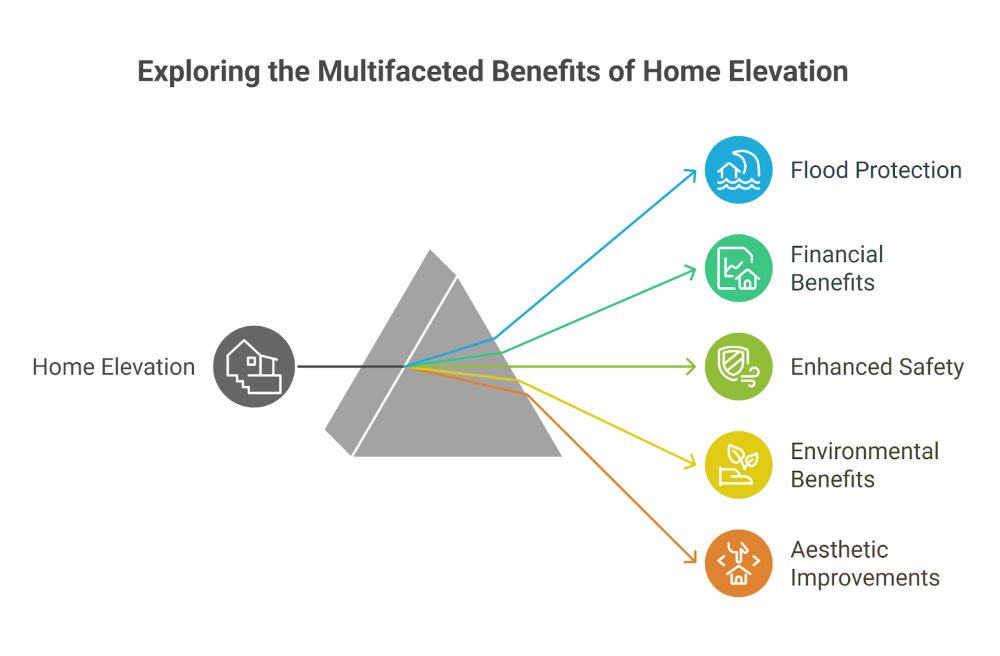
Storms in Suffolk County can be devastating, leaving homes damaged and families displaced.
As climate change brings more frequent and severe weather events, homeowners need to think about protecting their property.
Home elevation is a powerful way to safeguard against flooding and storm damage.
Raising a house above potential flood levels can save homeowners money and stress in the long run.
It reduces the risk of water damage, lowers insurance costs, and may even increase property value. Plus, it gives families peace of mind during storm seasons.
Elevating a home isn’t just about protection – it can also improve the look and function of a property.
Many homeowners use the renovation as a chance to update their home’s style or add useful space underneath.
With proper planning, home elevation can be a smart investment for Suffolk County residents.

Suffolk County faces growing risks from severe storms and flooding. Climate change has increased the frequency and intensity of extreme weather events in the area.
Past storms have caused major damage, highlighting the need for better preparedness.
Suffolk County has seen a rise in severe storms over the past decade. Data shows a 30% increase in storm events since 2015.
Rainfall intensity has also increased, with some storms dropping over 3 inches of rain per hour.
Hurricane-strength winds occur 40% more often than in the 1980s, and storm surge heights have increased by an average of 1 foot since 2000.
Flood events happen 25% more frequently now compared to 30 years ago. Areas once considered low-risk now face regular flooding issues.
Hurricane Sandy in 2012 caused widespread destruction in Suffolk County. The storm flooded over 95,000 buildings and left 900,000 customers without power.
In August 2021, Tropical Storm Henri brought record rainfall. Some areas received over 8 inches in just a few hours. This led to severe flash flooding and road closures across the county.
More recently, a severe thunderstorm in 2023 brought wind gusts up to 65 mph. It knocked out power to 43,000 homes and damaged countless trees and structures.

Home elevation is a key strategy for protecting houses in flood-prone areas. It involves raising a home’s structure to a safer height above potential flood levels.
This process can greatly reduce the risk of water damage during storms and floods.
The home elevation is lifting a house and placing it on a higher foundation. This technique raises a home above flood levels, protecting it from water damage. It’s especially important in coastal areas like Suffolk County.
The main goal is to keep the living space dry during floods. Elevating a home can help homeowners avoid costly repairs and ensure their property stays safe.
Home elevation also often leads to lower flood insurance rates. This can save homeowners money in the long run.
The home elevation process starts with a thorough assessment of the property. Engineers check the house’s structure and soil conditions.
Next, the house is separated from its original foundation. Special equipment lifts the entire structure.
While the house is raised, workers build a new, taller foundation. This might be concrete walls, piers, or posts.
Once the new foundation is ready, the house is lowered onto it. The process can take several weeks to complete.
After elevation, utilities are reconnected, and any necessary repairs are made. The result is a home that sits higher and safer.
There are several ways to elevate a home. The best method depends on the house type and local conditions.
Each method has pros and cons. Homeowners should consult with house-lifting services in New York to find the best option for their property.
Home elevation provides crucial protection against flooding in Suffolk County. It safeguards structures and belongings while offering long-term financial benefits.
Let’s explore the key advantages of elevating your home.
Elevating a home significantly lowers the chance of flood damage. In high-risk flood areas, raising a structure above the base flood elevation keeps it dry during most flood events.
This protects walls, floors, and electrical systems from water damage. It also keeps furniture, appliances, and personal items safe from floodwaters.
Elevated homes are less likely to suffer mold growth or structural issues caused by moisture. This can improve indoor air quality and lower maintenance costs over time.
For Suffolk County residents, home elevation is a key part of storm resilience. It helps protect against both coastal flooding and inland water accumulation during severe weather events.
While home elevation has a significant upfront cost, it can save money in the long run. Repeated flood damage can quickly surpass the price of elevating a structure.
Flood repairs often include:
These costs can add up to tens of thousands of dollars per incident. In contrast, elevation is a one-time expense that provides lasting protection.
Elevated homes may also qualify for lower flood insurance premiums. This ongoing savings can offset the initial investment over time.
Rising flood risks demand action. J. Brownie Contracting provides seamless home elevation services, ensuring long-term savings and storm protection. Get started today—schedule your consultation and keep your home safe for years to come.
If you’re ready to get started, call us now!
Elevating your Suffolk County home can bring substantial financial advantages. These benefits go beyond just protecting your property from flood damage.
Home elevation can lead to significant savings on flood insurance. In Suffolk County, elevated houses may qualify for reduced insurance rates. This is because elevated homes are at lower risk of flood damage.
The National Flood Insurance Program offers discounts for homes raised above the base flood elevation. These savings can be substantial over time.
Homeowners may see their premiums drop by hundreds or even thousands of dollars annually. The exact amount depends on factors like elevation, height, and location.
Elevating a home can boost its market value. This is especially true for coastal properties on Long Island.
Buyers often prefer elevated homes in flood-prone areas. They see them as safer investments.
Real estate experts note that elevated homes typically sell for higher prices. The increase can sometimes offset the cost of elevation.
Elevated homes may also attract more potential buyers. This can lead to quicker sales when it’s time to move.
Some homeowners may qualify for tax benefits after elevating their homes. These can include deductions or credits on federal or state taxes.
Suffolk County residents should consult with tax professionals about possible benefits. Rules and qualifications can change, so it’s important to get up-to-date information.
In some cases, the cost of home elevation may be tax-deductible as a home improvement expense, helping to offset the initial investment.
Local tax assessments might also be affected. Some areas offer property tax freezes or reductions for homes that undergo flood mitigation efforts.
Elevating your Suffolk County home provides crucial protection from flooding and storms. This upgrade offers both physical security and emotional comfort for homeowners in high-risk coastal areas.
The elevation of a home keeps valuable belongings safe from flood damage. Furniture, electronics, and important documents stay dry on higher floors.
Homeowners don’t need to rush to move items during storm warnings, which saves them time and stress when bad weather approaches.
Elevated homes also protect expensive systems like HVAC units and electrical panels. These stay above flood levels, reducing repair costs after storms. Appliances and vehicles in garages remain safe, too.
Living in an elevated home eases worry during hurricane season. Families feel safer knowing floodwaters can’t reach their living spaces, and this peace of mind is priceless for coastal residents.
Elevated homes often have stronger foundations and frames. These improvements make the house more stable in high winds. Homeowners can feel confident their property will stand up to severe weather.
The mental health benefits are significant. Less stress about storms means better sleep and lower anxiety. Families can focus on daily life instead of constantly fearing the next big flood.
“After J. Brownie Construction elevated our home, we sleep better at night. We used to watch the weather channel non-stop during storms. Now we don’t worry about flooding anymore.”
“Our neighbors had to evacuate twice last year. We stayed put, safe and dry. The investment was worth every penny for the peace of mind alone.”
“We can enjoy living near the water without constantly fearing losing everything. It’s changed our whole outlook on coastal living.”
Elevating your Suffolk County home provides crucial environmental and health advantages. It safeguards both your family and the surrounding ecosystem from flood-related hazards.
Home elevation significantly reduces mold and mildew growth. These fungi thrive in damp environments, often caused by flooding. When homes are raised, they stay drier during storms.
Mold can trigger allergies and respiratory issues. By keeping living spaces above flood levels, families can breathe cleaner air, which is especially important for those with asthma or other lung conditions.
Elevated homes also maintain better indoor air quality overall. Less moisture means fewer airborne spores. This creates a healthier living environment for all residents.
Floodwaters often carry contaminants like sewage and chemicals. When homes flood, these pollutants can seep into walls and floors. Elevating homes keeps these harmful substances out.
Clean drinking water is vital for health. Elevated homes are less likely to have compromised water systems during floods, protecting families from waterborne illnesses.
Plumbing and electrical systems also stay safer when elevated. This reduces the risk of electrocution and other hazards during flood events.
Elevated homes help protect local waterways and ecosystems. They allow floodwaters to flow naturally underneath, reducing erosion and runoff.
This natural flow helps maintain the balance of nearby wetlands and streams. It preserves habitats for local wildlife and plants.
Less runoff means fewer pollutants entering waterways, which helps keep fish populations healthy and maintains water quality. Waterfront property owners also benefit from cleaner, more stable shorelines.
Elevated homes also reduce the need for flood barriers, which can disrupt natural water flow and harm ecosystems. By raising homes, we work with nature rather than against it.
One storm can erase decades of hard work. Don’t wait for disaster to prove the risk is real. J. Brownie Contracting elevates homes, securing futures. Call now—because your home deserves better.
If you’re ready to get started, call us now!
Elevating your Suffolk County home offers more than just storm protection. It creates chances to enhance your home’s look and usefulness.
Home elevation opens doors for major design updates. You can change your home’s outer look with new siding, windows, or a fresh paint job. Inside, you might redo your floor plan or add modern features.
Many owners use this time to make their homes more energy-efficient. They install better insulation or update heating and cooling systems, which can lower energy bills and make the home cozier.
Some folks add decks or porches to their newly raised homes. These outdoor spaces can boost your home’s value and give you more room to enjoy.
Lifting your home can create a whole new floor. This space under the house has many uses. You could make a garage, a workshop, or extra storage.
Some people turn this area into a living space. It could become a guest suite, a home office, or a family room. Others use it for hobbies or exercise rooms.
This new space can add value to your home. It gives you more square footage without changing your home’s footprint. Plus, it’s a great way to add the extra room you’ve always wanted.
Elevating your Suffolk County home can lead to significant financial benefits over time. These savings come from reduced maintenance needs, improved energy efficiency, and protection from flood damage.
Home elevation drastically cuts down on flood-related repairs. Elevated homes face less moisture damage to foundations, walls, and floors. This means fewer issues with mold, rot, and structural weakening.
Regular maintenance costs also decrease. Homeowners spend less on repainting, re-carpeting, and replacing damaged furniture. Appliances and electrical systems last longer when protected from flooding.
Insurance premiums often drop for elevated homes. Many Suffolk County residents see lower flood insurance rates after raising their homes, and these savings add up year after year.
The home elevation process creates opportunities for energy upgrades. Homeowners can add insulation to walls and floors during construction. New, energy-efficient windows and doors are easy to install at this time.
Many choose to upgrade heating and cooling systems during elevation. This can include installing heat pumps or high-efficiency HVAC units. Proper sealing and ventilation improvements are also common.
These changes lead to lower energy bills. Some Suffolk County homeowners report 20-30% reductions in energy costs after elevation and upgrades.
Home elevation offers crucial protection against storms and flooding for Suffolk County residents. It safeguards property, increases home value, and provides peace of mind. Taking action now can prevent future losses and ensure long-term safety.
Elevating homes in Suffolk County provides multiple advantages. It protects against flood damage by raising the living space above potential water levels. This reduces the risk of structural damage and saves money on repairs.
Elevated homes often qualify for lower flood insurance premiums. This can lead to significant savings over time. Property values may also increase as elevated homes are more desirable in flood-prone areas.
The peace of mind that comes with a safer home is invaluable. Residents can feel secure knowing their belongings and loved ones are better protected during storms.
Climate change is increasing the frequency and intensity of storms. This trend is expected to continue, putting more properties at risk. Acting now can prevent future hardships and expenses.
Government assistance programs may be available, but funding is often limited. Homeowners who act quickly have a better chance of receiving financial support for elevation projects.
Watching floodwaters rise shouldn’t mean watching your savings wash away. J. Brownie Contracting lifts homes above flood zones, slashing insurance costs and preventing heartbreak. Act now—secure your home before the next storm strikes.
What factors should be considered when elevating a home in Suffolk County?
Homeowners must consider the home’s foundation, soil type, and flood zone, as well as its age and structure.
Local building codes play a big role, too.
Cost is another major factor. Elevation projects can be expensive. But they often pay off in the long run through lower insurance rates and less storm damage.
How does home elevation mitigate the risks of storm damage?
Elevating a home lifts it above flood levels. This keeps water out during storms and high tides. It protects floors, walls, and belongings from flood damage.
Elevated homes are also safer from wind damage. They’re less likely to be hit by debris carried by storm surges.
Are there any government grants or financial assistance programs available for home elevation in Suffolk County?
Yes, there are financial help options. New York State offers programs for storm-impacted homeowners, which can help cover the costs of elevation projects.
The Federal Emergency Management Agency (FEMA) also offers grants, which are often available after major disasters. Homeowners should check with local officials for current programs.
What are the zoning regulations and building code requirements for home elevation in Suffolk County?
Suffolk County follows state and federal flood regulations. Homes must be raised above the base flood elevation. The exact height depends on the flood zone.
Permits are required for elevation projects. Plans must be approved by local building departments. Inspections are done during and after construction.
How does home elevation impact home insurance premiums and coverage in storm-prone areas?
Elevated homes often qualify for lower insurance rates because they are less likely to flood. The savings can be significant over time.
Some insurance companies offer better coverage for elevated homes. This can include more protection from flood damage. Homeowners should talk to their insurance agents about specific benefits.
What is the typical process and timeline for completing a home elevation project in Suffolk County?
The process starts with planning and getting permits. This can take several weeks.
The actual lifting of the house usually takes a few days. After lifting, contractors build a new foundation and lower the house onto it.
The whole project often takes 3-4 months. Larger or more complex homes may take longer.